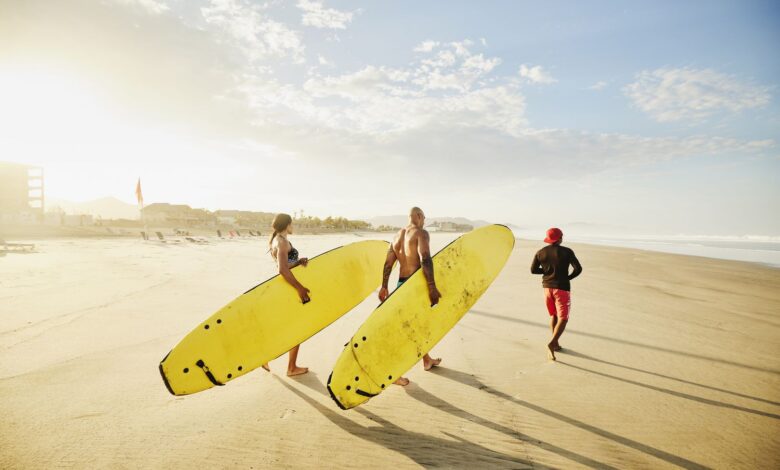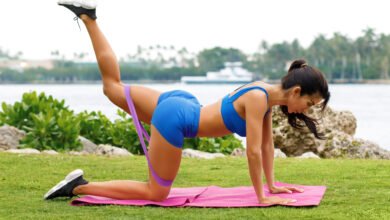12 Summer Sports You Need to Try

When summertime hits you know that means long days, warm (or hot!) nights, and lots of time to make memories with family and friends. One of the best ways to bond with your favorite people during your summer vacations (or even those long summer nights) is to engage in outdoor activities.
Whether you keep it low-key with a long hike or you take your adventure level up a notch and try your hand at surfing or scuba diving, outdoor activities can help boost mental health, keep you physically fit, and give you an opportunity to try something new.
The best thing about trying summer sports is there’s something for everyone. Whether you’re a water-lover looking to splash around with your friends, you’re a landlubber who prefers team sports like sand volleyball, or you’re looking to explore the scenery on your bike, you’re bound to find something you’ll enjoy. So if you’re making a list of “must dos” this summer, add at least a few of these outdoor summer sports to your lineup.
Water Sports
There’s no better time than the hot days of summer to hit the ocean, lake, river, or swimming pool. While joining a master’s swimming team or simply splashing around with your family is a great way to burn calories and stay cool, you should consider trying a few of these more adventurous water sports, too.
Surfing: How to Catch a Wave
If you’ve never picked up a board and tried to catch a wave, you’re missing out on an experience. The thrill of hopping up, staying balanced, and riding a wave to the shore is guaranteed to bring a smile to your face. And while you may think surfing is a sport for young bucks, there’s no reason why a reasonably active adult of any age can’t give it a try.
Your best bet, though, is to sign up for a lesson from a credentialed and experienced instructor. They will give you surfing tips, guide you through the intricacies of paddling out and hopping up, and tell you when to make your move safely (and give you a push if you need it). There are just a couple of things to keep in mind.
Depending on the location, you may need to wear a wetsuit to keep you warm in the water, and you’ll likely need a rash guard if you’re using a beginner board (the foam that helps keep the board stable can cause rubbing and rashes). While you likely think of the sport as requiring balance and lower body and core strength (which is true), it’s your arms that will really get a workout.
Paddling out past the breakers and paddling to catch each wave requires a lot of shoulder and triceps strength. And keeping your chest up as you paddle also works your upper back. When you add that to the work your lower body and core do to help keep you stable, surfing really is a total body workout. Don’t be surprised if you end up sore a couple of days later.
Paddleboarding: The Perfect Way to Explore the Water
If you’re not quite up for surfing, but you still want to explore open water on a board, paddleboarding might be right up your alley. Generally speaking (unless you’re doing ocean or whitewater paddleboarding), the sport is more leisurely than surfing, allowing you to cruise rivers or lakes on a longer, wider board that offers a bit more stability than a surfboard. It’s a great activity to do with a group of friends but can be equally enjoyable alone.
While paddleboarding is a sport you can try on your own without instruction, you may want to sign up for a lesson or guided tour your first time out. An experienced instructor can provide you with tips for balance and how to use the paddle most effectively. In addition to the board itself, you’ll want to have a lifejacket with you and of course, your swimwear.
Paddleboarding, generally, is considered more low-key than surfing because it typically takes place in calmer settings and can be done at your own pace. But don’t mistake “low-key” for “easy.” Paddleboarding can be quite the workout.
Like surfing, it requires the engagement of the lower body and core to maintain balance. Your arms, shoulders, and upper back may start to burn from the paddling. If you’re up for a different type of challenge, you can even give paddleboard yoga a try. Doing downward dogs on a paddleboard takes the balance challenge up a notch.
Kayaking: Adventure and Sightseeing in One Activity
If you prefer to tour lakes, rivers, and oceans while sitting rather than standing, kayaking might be your best bet. Just keep in mind that not all kayaks (or kayaking locations) are not created equal. Small one- or two-person boats are typically long and flat, which is ideal for less-involved flat-water kayaking. If you’re looking for more challenging river or whitewater situations, you’ll want a shorter, deeper kayak.
To learn how to use a more traditional river kayak (the deeper style that you sit inside), it’s important to get a few lessons in a swimming pool or calm water before heading to the river. This is especially true if you want to use your kayak to navigate rapids. It’s important to know how to effectively use your oar to stay balanced and in control. And if the kayak does flip, you need to know how to use your oar to turn yourself back upright again.
For a more relaxed tour of flat or calm waterways, opting for a lake or ocean kayak that you sit on top of is a better bet. You’ll still want to have a lifejacket with you, but you can take things at a more tranquil pace with greater control over your speed. Like paddleboarding, you may still want to enlist a tour guide to take you out as an individual or group, but you can also rent or buy a kayak and learn as you go without too much trouble.
Regardless, kayaking has many health benefits. It works your upper body, builds cardiovascular strength, and offers a low-impact form of exercise that’s easy on the joints.
Scuba Diving or Snorkeling: The Thrill of Exploring the Underwater World
To take your summer sports under the water, snorkeling or scuba diving are options worth investigating. Snorkeling is more accessible—tours are typically open to swimmers of most ability levels, and it’s possible to buy or rent a snorkel and head out on your own. Stick to a buddy system to maximize safety, though. This option is also comparatively less expensive than other water sports as it doesn’t require large equipment or accessories.
If you’re truly dedicated to investigating the deep waters, though, scuba diving will give you the opportunity to see landscapes and animals you’d never see surfing, kayaking, or even snorkeling. But, you need to go through a series of classes and receive a certification from the Professional Association of Diving Instructors (PADI) in order to be qualified to take a supervised dive.
Diving underwater, especially in deeper spots, can be dangerous without supervision, appropriate education, and assistance. If you’re willing to pay for the classes, equipment rentals, and tours, the underwater experiences are almost certainly worth the cost.
Whether you choose snorkeling or scuba diving, the activities likely qualify as low- to moderate-intensity exercise. You’ll need to know how to swim, and you should feel comfortable in deep, open-water settings. Your pace will most likely be slow in order to really enjoy your surroundings, but you’ll still feel your whole body working as you swim against the resistance of the water.
Land Sports
If you’re not a fan of water sports, there are still plenty of summer sports you can enjoy while on land. Just remember to stock up on sunscreen and cold liquids. The last thing you want is to end up burned or dehydrated while enjoying your summer activities.
Beach Volleyball: Fun in the Sun With a Group
Beach volleyball is one of those activities that can be fun for the whole family, and can be leveled up or leveled down depending on who wants to take part. If you decide to go the more competitive, traditional route, you might want to sign up for a summer league with friends to play regular games of two-on-two.
This type of league is a serious workout as you and your partner have to cover the whole expanse of the volleyball court together as you bump, set, and spike the ball back and forth against your competition. You can expect to feel your calves and quads burning as you run and jump in the loose sand, and your core and upper body will be tested as you volley the ball.
If competitive volleyball seems entirely too serious, don’t sweat it. You can enjoy pick-up games with family and friends with as many participants as you want per team. This means there’s less space to cover and less running and jumping required. You can even switch out a standard volleyball for a beach ball that moves slower, making it an activity that’s accessible to kids and older adults.
Cycling: Scenic Rides for a Calm and Rejuvenating Experience
Cycling is one of those outdoor sports that you can enjoy on your own or as part of a group. It’s also an activity you can do at home or as you travel. Most destinations offer bike rentals and bike tours to give visitors a chance to exercise while sightseeing.
Depending on your desire to use the sport for exercise or as a more leisurely pastime, you can make adjustments to your intensity and the terrain you choose to navigate. For instance, opt for a hilly trail ride if you want a serious workout that will help strengthen your legs while boosting your cardiovascular health.
Or if you want to take it easy, stick to a tour through flat streets and bike paths and go at your own pace. You’ll still work your legs and your heart but at a more moderate level of intensity. If you don’t know where to start, check your local bike shops for information on cycling groups or free clinics to walk you through the basics.
Hiking: The Perfect Mix of Adventure and Sightseeing
Hiking is an excellent outdoor activity because it’s readily accessible and can be enjoyed by people of most fitness levels and ages. Like cycling, the intensity of your hikes boils down to where you choose to go, how long the hike will take, and how fast or hard you plan to push yourself. For beginners, exploring local trails that wander along rivers or lakes can be a great option. These are typically flatter, shorter hikes you can do with nothing more than a pair of high-quality athletic shoes or a pair of hiking boots.
More advanced hikers, on the other hand, may want to consider destination hikes that involve mountainous terrain. What you’ll need to pack depends on where you’re going, what type of weather you’ll be dealing with, and how long you plan to hike. A simple pair of hiking boots may be sufficient, but you may also need gear like hiking pants, a backpack, water or snacks, a change of clothes, and a hammock or light tent if you plan on a multi-day trip.
Rock Climbing: The Challenge of Ascent and Getting Closer to Nature
For those who have no fear of heights, rock climbing can be an incredibly fun activity to try with family and friends. While rock climbing may look like a solo sport, it’s really one that should be done as part of a group. Each climber requires a partner to help keep them safe as they scale rocks and the sides of cliffs. And because rock climbing carries with it inherent danger (falling from a cliff is not a risk to be taken lightly), it’s important to sign up for instruction from a certified climber before giving it a go.
Rock climbing gyms and rock climbing tour groups in popular climbing destinations often offer group trips based on ability level. There’s a lot of equipment you’ll need to use—climbing shoes, harnesses, and ropes—but you can typically rent the equipment your first few times to get an idea of what you’ll need before making the investment in your own gear.
Pickleball and Other Racquet Sports
Pickleball is one of the fastest growing sports in the country, largely because it’s fun, accessible, and can be enjoyed across the lifespan. These same benefits are what makes other racquet sports like tennis, racquetball, and even badminton, similarly popular.
In addition to offering a good workout—you have to run to cover the court, use your legs to move to the ball, and your upper body to volley it back and forth—pickleball and other racquet sports offer an active social opportunity to engage with friends. And not unlike volleyball, the requirements to get started are minimal. A sport-appropriate racquet, a few balls, and a good pair of court shoes are really all you need.
More Accessible Sports for Every Location
While hiking, cycling, and beach volleyball may be fairly accessible summer sport options, you don’t have to be an adventure seeker to take advantage of other summer fitness opportunities. The following options are available to almost all ages and ability levels and require little to no equipment, instruction, or know-how to get started.
Walking or Running
Walking is quite possibly the most accessible summer activity you can do to stay active. All you need is a good pair of walking shoes to get started. Once you’ve laced up your kicks, simply step outside and get going. You can take it at a slow pace for short jaunts, or you can edge into speed-walking territory with a quick, short stride and a higher level of intensity.
Running really requires no more than walking, although having the right running shoes is important. You can take up the activity on your own, or you can join a local running club (or simply enlist a running buddy) to maximize the social side of the sport.
You may also want to sign up for races to amp up the competition level, too. One thing is clear, though: running qualifies as a more intense form of exercise, so expect to feel sore and tired, particularly through your legs and core, after your first few attempts.
On particularly hot days, you may want to keep your walks or runs confined to the first few hours of the day or after sunset when it’s a little cooler outside. Likewise, it’s a good idea to walk or run in shady areas and to carry water with you.
Also, it’s important to adhere to the buddy system when heading outside. Even if you don’t walk or run with someone else, you should always let someone know where you’ll be and when you plan to return. Little steps like this can help keep you safe in the event of an accident or a bad encounter with an animal or another person.
Swimming
Swimming is another outdoor sport that’s hard to beat in terms of accessibility with just a few caveats: you need access to a pool or a body of water, and you need to know how to swim. If you plan on swimming at a pool, proper swimwear is likely to be required, and you may want additional equipment like goggles, a kickboard, or flippers. If you’re hitting a lake or river? A life jacket is well advised, as these areas can be less predictable.
Swimming, like walking, running, hiking, and cycling, can be as challenging or as leisurely as you desire. More advanced swimmers may want to join a master’s swim team (swim teams for adults) to engage in regular, more strenuous practices alongside other competitive swimmers. Leisure-seekers, on the other hand, may not even want to actively swim laps or perform specific strokes. Rather, they may want to simply play around in the water with family and friends.
Yoga
Yoga is one of those activities that seamlessly transfers from an indoor activity to an outdoor one. All you need is a yoga mat, a bottle of water, and a little bit of know-how and you can take your yoga practice practically anywhere.
Many studios and instructors offer outdoor classes during the summer months, and this is particularly true at vacation destinations. While working with an instructor is almost always advisable, you also can follow an online class or simply make up your own flow.
Bottom Line
Summer sports can help keep you fit during the hottest months of the year while also amping up social opportunities, improving mental and physical health, and keeping fitness fun. There are lots of summer sports to choose between, like water-based activities, land-based activities, and even lowkey activities that are widely accessible to all ability levels and ages.
When choosing a summer sport, consider whether you’ll be doing the activity alone or as part of a group, whether you want a more rigorous level of intensity or something more laid back, and what type of equipment or instruction you’ll need to rent, buy, or enlist to enjoy the sport. Set a budget, choose a destination, and give a few of the aforementioned options a try. You won’t regret the decision. Just be sure to consult with a healthcare provider if you are new to exercise to ensure what you are considering is right for you and your fitness level.




